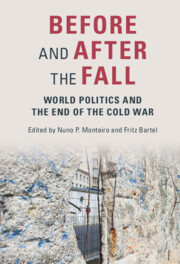Book contents
- Before and After the Fall
- Before and After the Fall
- Copyright page
- Dedication
- Epigraph
- Contents
- Figures
- Tables
- Contributors
- Preface
- Introduction
- Part I Sources of Continuity and Change
- Part II Continuity and Change Across the 1989/1991 Divide
- Part III Toward a New World Order?
- 12 Great Powers and the Spread of Autocracy Since the Cold War
- 13 Seeds of Failure
- 14 The United States and NATO After the End of the Cold War
- 15 The Historical Legacy of 1989
- 16 Requiem for a Cold War
- 17 After Primacy
- 18 World Order across the End of the Cold War
- Index
13 - Seeds of Failure
The End of the Cold War and the Failure of the Russian Democratic Transition and Western Integration
from Part III - Toward a New World Order?
Published online by Cambridge University Press: 02 December 2021
- Before and After the Fall
- Before and After the Fall
- Copyright page
- Dedication
- Epigraph
- Contents
- Figures
- Tables
- Contributors
- Preface
- Introduction
- Part I Sources of Continuity and Change
- Part II Continuity and Change Across the 1989/1991 Divide
- Part III Toward a New World Order?
- 12 Great Powers and the Spread of Autocracy Since the Cold War
- 13 Seeds of Failure
- 14 The United States and NATO After the End of the Cold War
- 15 The Historical Legacy of 1989
- 16 Requiem for a Cold War
- 17 After Primacy
- 18 World Order across the End of the Cold War
- Index
Summary
Thirty-years on, the high expectations that accompanied the end of the Cold War and the collapse of Soviet communism have been largely confounded by the emergence of the autocratic Putin regime and the rekindling of Great Power rivalry between Russia and the United States. In this chapter, we argue that these outcomes were not inevitable, but rather were significantly the result of failures in Western, and particularly American, statecraft during the 1990s. First, the democratic transition was undermined by the type of economic transition, which Western policy networks promoted in post-Soviet Russia. Had Western influencers promoted a New Deal or social democratic model of economic transition, the distributional effects which undermined the legitimacy of the Yeltsin regime would have been far less severe. Second, the American failure to devise and pursue a strategy to effectively integrate Russia into a post-NATO European security architecture made it almost certain that “left out” Russia would react negatively to NATO expansion to the East. Had the United States followed up on Gorbachev’s vision of security architecture for a “Common European Home,” the ongoing clash between Russia and the West might well have been averted.
- Type
- Chapter
- Information
- Before and After the FallWorld Politics and the End of the Cold War, pp. 244 - 264Publisher: Cambridge University PressPrint publication year: 2021

